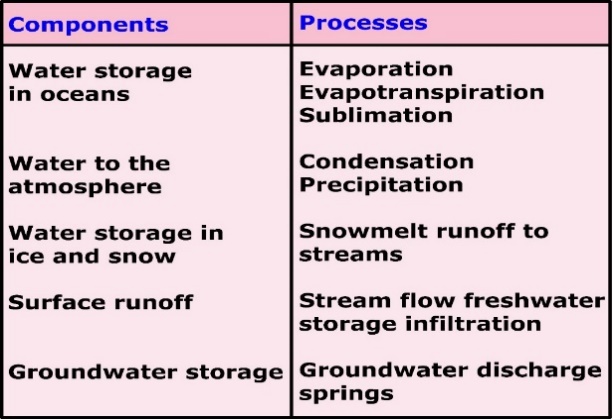Hydrological Cycle
Water circulates within the hydrosphere of the earth in the form of gas, liquid, and solid. This movement of water is known as the hydrological cycle. Because of this cycle, the water gets exchanged between land, atmosphere, ocean, and organism subsurface.
- As water can be reused and recycled, it is known to be a cyclic resource
- The movement of water i.e. a cycle occurs in a to-and-fro path from the ocean and land
- Water is unevenly distributed on the surface of the earth. Some places have it in abundance, whereas there is a scarcity of water in some places
- Approximately 71% of the water on the Earth is found in the oceans. The remaining water can be found in lakes, glaciers, ice-caps, groundwater sources, soil, and within the different forms of life
- Around 59% of the water that reaches the land goes back into the atmosphere through evaporation. Evaporation happens at oceans and from other locations as well
- The remaining water gets vanquished on the surface or reaches inside the ground or gets developed into a glacier
- There is a continuous demand for water across the world. However, as the water that can be renewed remains the same, water crises are faced consistently or temporarily by different regions.
Table: Components and Processes of the Water Cycle

Relief of the Ocean Floor
- Oceans are found in greater depths from the earth’s surface
- Unlike the continents, oceans meet each other seamlessly, and it becomes hard to distinguish them.
- Indian, Pacific, Arctic, Atlantic, and Southern Ocean are earth’s five distinct oceans according to the geographers
- Oceans comprise inlets, bays, gulfs, and different seas
- A majority of the ocean floor can be traced between 3 and 6 kilometres below the sea level
- The ocean floor i.e. land which is below oceanic waters showcases features that are varied and complex as compared to the regular land
- The ocean floor is uneven with the vast plains, the deepest trenches, and biggest mountain ranges. This happens through volcanic eruptions, depositional processes, and tectonic movement similar to those that happen on the continents
Divisions of the Ocean Floors
- ocean floors are divided into four major divisions, i.e. the Continental Shelf; the Continental Slope; the Deep Sea Plain; and the Oceanic Deeps
- there are also major and minor relief features in the ocean floors like ridges, hills, sea mounts, guyots, trenches, canyons, etc
Temperature of ocean waters
- ocean waters get heated up by solar energy
- process of heating and cooling of the oceanic water is slower than land.
Factors Affecting Temperature Distribution
- factors that affect the distribution of temperature of ocean water are latitude, unequal distribution of land and water, prevailing wind and ocean currents
- latitude: the temperature of surface water decreases from the equator towards the poles because the amount of insolation decreases poleward
- unequal distribution of land and water: the oceans in the Northern Hemisphere receive more heat due to their contact with larger extent of land than the oceans in the Southern Hemisphere
- prevailing wind: the winds blowing from the land towards the oceans drive warm surface water away from the coast, resulting in the upwelling of cold water from below
- ocean currents: warm ocean currents raise the temperature in cold areas, while the cold currents decrease the temperature in warm ocean areas.
Horizontal and Vertical Distribution of Temperature
- temperature-depth profile for the ocean water shows how the temperature decreases with the increasing depth
- this profile shows the boundary region between surface waters of the ocean and the deeper layers
- boundary generally begins around 100 – 400 m below the sea surface and extends several hundred metres downward
- almost 90 percent of the total volume of water is found below the thermocline in the deep ocean; in this zone, temperatures approach 0° C
- first layer represents the top layer of warm oceanic water, and it is about 500 m thick with temperatures ranging between 20° and 25° C
- this layer within the tropical region is present throughout the year, but in mid-latitudes it develops only during summer
- second layer called the thermocline layer lies below the first layer and is characterised by rapid decrease in temperature with increasing depth and is 500 – 1,000 m thick
- third layer is very cold and extends up to the deep ocean floor, in the Arctic and Antarctic circles, the surface water temperatures are close to 0° C and so the temperature change with the depth is very slight
- boundary generally begins around 100 – 400 m below the sea surface and extends several hundred metres downward
Conclusion
Water circulates within the hydrosphere of the earth in the form of gas, liquid, and solid, and this movement of water is known as the hydrological cycle. Because of this cycle, the water gets exchanged between land, atmosphere, ocean, and organism subsurface. The maximum temperature of the oceans is always at their surfaces because they directly receive the heat from the sun and the heat is transmitted to the lower sections of the oceans through the process of convection.
 Profile
Profile Settings
Settings Refer your friends
Refer your friends Sign out
Sign out












